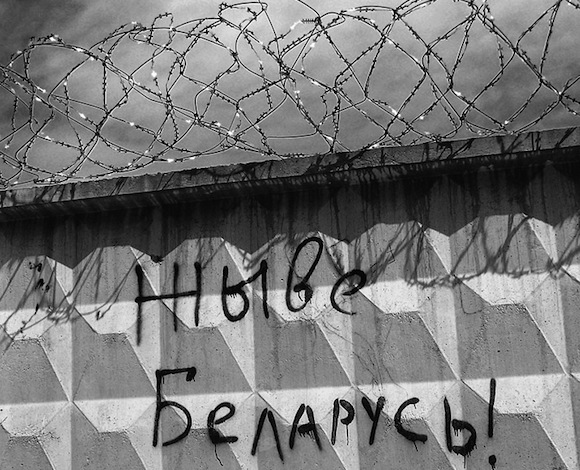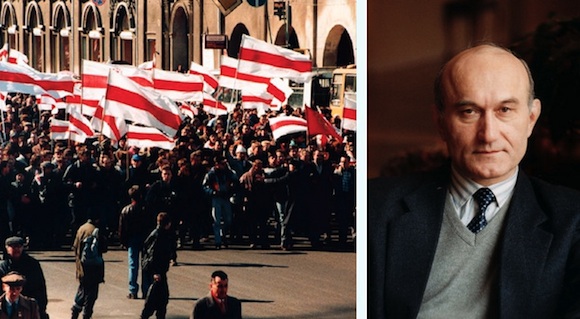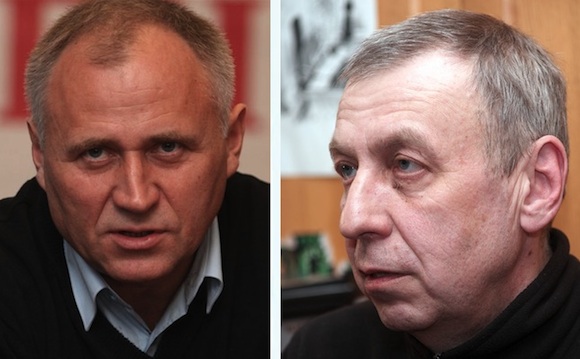The Institute of Modern Russia completes its series of articles on the political history of contemporary Belarus. In the first two installments, we discussed Alexander Lukashenko's dashing rise to power and the country's transformation under his 18 year-long rule. In the concluding part, we'll focus on various efforts that Belarusian opposition puts into the struggle with Lukashenko's regime. Today, with Belarusian economy sagging and the country's model of "social protectionism at the expense of political freedoms" failing to deliver, it seems that the last dictatorship is Europe is entering its twilight.

Despite Lukashenko's 18 years in power, some parts of Belarusian opposition does not lose faith in the country's better tomorrow. Photo by Sergei Melnikov.
Public Compromise
In the light of Lukashenko’s recent political and economic failures, it is instructive to look at the extent to which the public mood has changed in Belarus. Polls by the Independent Institute of Social, Economic and Political Studies (IISEPS) show that the public remains politically apathetic. Mobilization authoritarianism is still an acceptable model for the majority of the Belarusians.
At the end of 2011, IISEPS tried to determine the Belarus’ people’s disposition to protest. Respondents were asked: "If protest rallies against the deteriorating economic situation were to take place in your town (district), would you participate?" 14.7% said “yes;” 73.9% said “no;” and 11.4% were undecided. To put this in perspective, in December 2008, respondents’ replies to the same question were: 18.6% said “yes;” 71.8% said “no;” and 9.6% were undecided. In September 2007, the results were almost identical to the December 2008 results. Thus, the public doesn’t see economic problems as an incentive for protesting. In the last ten years public readiness to participate in protests and rallies has remained unchanged: in 2001, 16.7% of the population were willing to go to the streets, in 2006—15.1%, in 2010—11.8%. There was a slight spike (apparently, caused by the financial crisis), which made the number go up to 16%, but by the end of 2011, it fell to 14.8%.
For many years the majority of respondents in IISEPS polls did not consider themselves as opposition. In April 2006, only 18.5% confirmed that they were opposed to the regime, in 2008—18.6%. During the 2011 crisis, the public mood changed slightly: in June, 26.8% acknowledged that they had were opposed to the government; in September, the number grew to 28.3%, but in December, it declined to 22.6%.
A dictatorship is usually sustained by the majority’s silent approval.
On September 2012, Belarus held parliamentary elections that, as many times before, were not recognized by international organizations, such as European Union or OCSE. Opposition parties boycotted the elections. But despite that, according to IISEPS polls, 47.5% of the voters called this election “free and fair;” only 27% disagreed. 27.2% said that “falsifications took place during the election,” while 41.7% expressed an opposing opinion.
Thus, even according to independent studies, the majority of the Belarusian population appear to support the Lukashenko’s regime. One should note that a dictatorship is usually sustained by the majority’s silent approval (given voluntarily or through force). The social protectionism offered by Lukashenko as an alternative to the “destructive chaos of the democracy” of early 90’s remains acceptable for the public.
Moreover, as in most authoritarian countries, the government controls all major sources of information: television, radio, the press and the internet. There is over 50% internet penetration in Belarus; Beltelecom, the major internet provider, is a state monopoly. In mid-2012, 4.3 million Belarusian people were using its services. Until recently, Beltelecom also controlled all the information coming into the country through its external internet gateways. On December 1st, 2010, National Center for Traffic Exchange took over the management of the country’s internet network. The new company supervises the Single Republican Data Network combining all the “civilian” data networks of Belarus. Incidentally, the National Center is controlled by the President’s Operational and Analytical Center. Since 2010, the Belarusian authorities have maintained a “black list” of about 80 banned websites that includes such opposition sites, like charter97.org and belaruspartizan.org.
Still, despite the fact that the majority of the Belrusian public accept Lukashenko’s model of rule, they are beginning to be alienated by the very person of the president. The decline in Lukashenko’s personal standing is revealed in a series of IISEPS’ polls, entitled “Erosion of the Strong Leader Image.” In December 2010, 53% of those surveyed gave Lukashenko a positive rating; in March 2011—42.9%; in June 2011—29.3%; and in September 2011—20.5% (a historical low). Then his rating started to grow but never exceeded 40%. As of September 2012, Lukashenko’s rating was 31.6%.
Even though the Belarusian people are losing faith in the idea of a strong leader and in Alexander Lukashenko, who has personified this idea, they do not see an alternative among the members of the opposition. In September 2012, IISEPS conducted a poll asking just one question: “If presidential elections were held tomorrow, whom would you vote for?” The respondents gave the following answers:
- Alexander Lukashenko — 34.5%
- Andrei Sannikov — 6.1%
- Vladimir Neklyayev — 5.3%
- Sergei Sidorsky — 5.0%
- Alexander Milinkebich — 4.9%
- Alexander Kozulin — 3.4%
- Zenon Poznyak — 2.7%
- Anatoly Lebedko — 2.4%
- Mikhail Myasnikovich — 1.8%
- Vladimir Makey — 1.0%
- Sergei Kalyakin — 1.2%
- Undecided — 31.7%.
These numbers demonstrate that Lukashenko’s popularity has dropped as a result of improved ratings for the opposition (the collective approval rating for all opposition candidates is 33.8%, still less than the rating for the Belarusian President), but rather due to the increasing number of those voters who do not see any of the candidates as representing their interests.
Fractured Opposition
Compared to Russia, the Belarusian political landscape is characterized by the large number of opposition parties. Overall, 15 parties are officially registered in Belarus. Nine of them are in opposition, including: the Belarusian People’s Front (BPF), the Belarusian Social Democratic Gromada, the Belarusian Social Democratic Party (Gromada), the United Civil Party (UCP), Belarusian United Party of the Left, “Just World” (former Belarusian Communist Party), the Conservative Christian Party—BPF, the Social Democratic Party of People’s Consent, the Belarusian Green Party, and the Liberal Democratic Party.

In case of Belarus, political pluralism resulted in diluting the vote for the opposition. One of the first parties of contemporary Belarus, BPF, split in December 1999. Its former leader Zenon Poznyak (right) and a number of other former members founded a new party.
Formally, in Belarus there is an element of political pluralism that is lacking in Russia and for which Russia is criticized by Western countries and Russia’s internal opposition. But in case of Belarus, this pluralism results in diluting the vote for the opposition. The majority of Belarusian political parties are more like political clubs: no one of which is able to garner more than 5% of the vote. In general, the Belarusian political culture has anti-party characteristics, and the country’s electoral legislation hinders people from joining in and registering parties. Moreover, the Belarusian President uses his public speeches and the force of his propaganda machine to attack opposition parties in order to marginalize and discredit them. At the same time, intraparty fights and the inability of opposition parties to co-operate with each other has played into Lukashenko’s hands.
One of the first parties of contemporary Belarus, BPF, split in December 1999. Its former leader Zenon Poznyak and a number of other former members founded a new party: the Conservative Christian Party—BPF (CCP-BPF). After the split, BPF’s approval rating declined. By the end of 2003, BPF had the support of 2.5% of the population, while CCP-BPF’s support was 1.8%.
The Belarusian Social Democratic Party (Gromada), or BSDP, also went through a series of crises. In 1996, after the party tried to merge with the Party of People’s Consent, a group of BSDP leaders, including Oleg Trusov, Viktor Gonchar and Gennady Karpenko (who had joined after leaving the UCP), resigned. In 2001, after uninterrupted intraparty strife, almost half of its members quit. The internal dissension is ongoing with various levels of intensity.
In May 2007, the opposition parties, despite their various conflicts, managed to form a coalition called the United Democratic Forces (UDF). But in 2008 and 2012 parliamentary elections, none of the UDF members was elected. To be fair, the opposition boycotted the most recent election that was held on September 23, 2012. Vladimir Borodach, former Foreign Military Intelligence (GRU) officer and a political exile residing in Germany, told IMR that the opposition could not find common ground even on how to announce this boycott. “Lack of solidarity is the opposition’s major ailment and this is a misfortune for the whole country as well.”
The majority of Belarusian political parties are more like political clubs: no one of which is able to garner more than 5% of the vote. In general, the Belarusian political culture has anti-party characteristics.
Grigory Ioffe, Professor of Radford University (in Virginia), an expert in post-Soviet countries and author of studies on Belarus, explained this stalemate: “The problem of the Belarusian opposition is that it is personified by the people who work with various sponsors, including European organizations. Many of them live outside of Belarus and feel quite comfortable. Many of them need Lukashenko, because they receive good money for their struggle against him. And thanks to him they can call themselves anti-Lukashenko crusaders. If he disappears, who will need them?”
In Anatoly Lebedko’s opinion, the biggest problem of the opposition is lack of direct communication with people. “Any attempts to reach out are immediately interrupted and suppressed by the government,” he told IMR. “Only four times a year is the opposition given a chance to speak on state television and radio. What is permitted is a five-minute recorded speech as a part of the parliamentary election campaign and there is no guarantee that the recording will be broadcast. For example, during the last campaign, in September 2012, 34 addresses by UCP candidates were never aired.”
As in Russia, where authorities denounce the opposition for receiving financial support from Western organizations, including the U.S. State Department, Lukashenko cannot find a better explanation for the existence of opposition activities than calling it a “fifth column.” When the opposition parties announced a boycott of the recent parliamentary election, Lukashenko stated: “I often say this is not political opposition. An opposition would struggle, fight for the power, for the interests of the people, or for something else. But [these people] are a “fifth column,” they act in the interest of certain forces that are usually based outside our country. An opposition would fight, a fifth column would destabilize the situation by these very methods.”
Another opposition problem is they have no unequivocal leader, a compromise figure that would be accepted by all opposition forces. This political vacuum is largely due to Lukashnko’s efforts which include killing his rivals. For example, Viktor Gonchar (mentioned in parts one and two of this series), who could have become a real alternative to the Belarusian President, disappeared without a trace in 1999.

Both former candidates for presidency in 2010 elections, Nikolay Statkevich (left) and Andrei Sannikov (right) were arrested and served time in prison for their political views. While Sannikov was released on pardon this spring, Statkevich still remains in jail.
For Lukashenko, a softer method of fighting the opposition, is imprisonment. Today, all the members of Belarusian opposition have prison records, to say nothing of the time many have spent in detention centers. One of the recent examples is what happened to Andrei Sannikov, a former Deputy Foreign Minister and a leader of the European Belarus movement. According to official data of Central Election Commission (CEC), he was a runner-up in 2010 presidential elections with 2% of the vote although he may have actually received as much as 14% according to exit-polls data collected by TNS, a global market research company.
On the night of December 19, during the mass protest that took place after the presidential election, Sannikov was arrested. He was accused of organizing mass rioting and sentenced to five years in a prison colony with a strict regime. On January 11 2011, Amnesty International recognized him as a “prisoner of conscience.” According to his wife, Irina Khalip, a reporter for Novaya Gazeta, Sannikov was tortured and threatened that reprisals would be taken against his family unless he signed a petition for forgiveness addressed to President Lukashnko. After a period of threats and physical force, Sannikov signed the petition. As Irina Khalip later noted, it was Lukashenko’s personal vendetta for a joke that Sannikov used during his election campaign: one of the slogans of his campaign read “Lets change the bald tire”—a reference to Lukashenko’s baldness.
Even more grim was the fate of Oleg Babenin, creator of the opposition website charter97.org and likely head of Sannikov’s compaign office. Before the campaign even started in September 2010, Babenin was found hanged in his country house. On April 14, 2012, after the EU imposed sanctions against Belarus, Sannikov was released from the penal colony and was granted political asylum by the United Kingdom in October.
As in Russia, where authorities denounce the opposition for receiving financial support from Western organizations, including the U.S. State Department, Lukashenko cannot find a better explanation for the existence of opposition activities than calling it a “fifth column.”
The only former presidential candidate remaining in jail is Nikolay Statkevich. He categorically refuses to sign a petition of mercy. Statkevich is a leader of Belarusian Social Democratic Party (People’s Gromada) that has been acting as an organizing committee since 2005. Like other participants of the December 19, 2010, protest rally, he was beaten and arrested. He has been recognized as a “prisoner of conscience” by Amnesty International. In May 2011, he was sentenced to six years at a strict regime penal colony. It was the most severe verdict imposed on those who participated in the December 19 protests.
A year ago Statkevich managed to break information blockade and to publish his so-called “political letters.” In his writings, he described the severe conditions of the everyday life in prison. To punish him for this “prank,” the colony administration hardened his regime to three more years of imprisonment under strict regime. In an interview with Interfax, his wife, Marina Adamovich, said that Statkevich was considered a “persistent violator of the regime. Now he is allowed only one hour-long walk outdoors per day, one short visit from family per year and one package per year.”
Statkevich was regularly put under pressure in order to sign a petition of pardon, but this July he made a request for the authorities not to approach him about petitions anymore. He is still the only former presidential candidate who remains in prison for December 19 protests.

